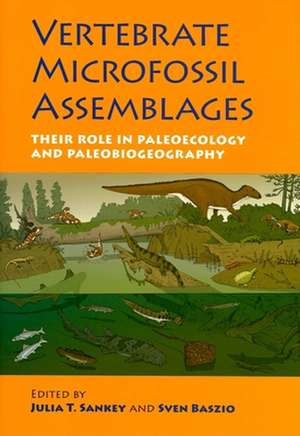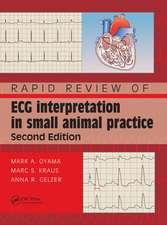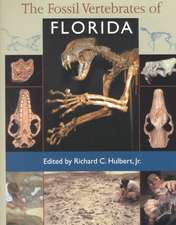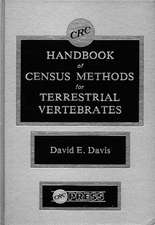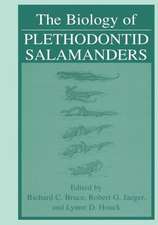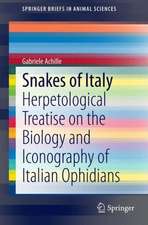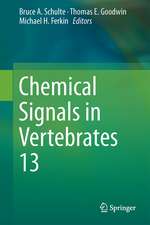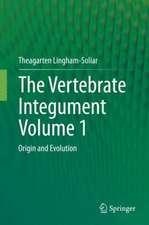Vertebrate Microfossil Assemblages – Their Role in Paleoecology and Paleobiogeography: Life of the Past
Autor Julia T. Sankey, Sven Baszioen Limba Engleză Hardback – 16 apr 2008
Din seria Life of the Past
-
 Preț: 300.55 lei
Preț: 300.55 lei - 19%
 Preț: 569.33 lei
Preț: 569.33 lei -
 Preț: 221.08 lei
Preț: 221.08 lei - 15%
 Preț: 433.14 lei
Preț: 433.14 lei -
 Preț: 281.32 lei
Preț: 281.32 lei -
 Preț: 334.12 lei
Preț: 334.12 lei -
 Preț: 261.11 lei
Preț: 261.11 lei -
 Preț: 383.09 lei
Preț: 383.09 lei -
 Preț: 375.72 lei
Preț: 375.72 lei -
 Preț: 349.91 lei
Preț: 349.91 lei -
 Preț: 323.95 lei
Preț: 323.95 lei -
 Preț: 301.56 lei
Preț: 301.56 lei - 19%
 Preț: 374.26 lei
Preț: 374.26 lei - 19%
 Preț: 394.66 lei
Preț: 394.66 lei -
 Preț: 176.15 lei
Preț: 176.15 lei -
 Preț: 275.60 lei
Preț: 275.60 lei - 15%
 Preț: 551.48 lei
Preț: 551.48 lei -
 Preț: 261.16 lei
Preț: 261.16 lei -
 Preț: 392.41 lei
Preț: 392.41 lei -
 Preț: 303.60 lei
Preț: 303.60 lei -
 Preț: 411.29 lei
Preț: 411.29 lei -
 Preț: 239.32 lei
Preț: 239.32 lei -
 Preț: 330.52 lei
Preț: 330.52 lei -
 Preț: 341.47 lei
Preț: 341.47 lei - 8%
 Preț: 547.92 lei
Preț: 547.92 lei - 8%
 Preț: 503.65 lei
Preț: 503.65 lei -
 Preț: 452.84 lei
Preț: 452.84 lei -
 Preț: 345.35 lei
Preț: 345.35 lei -
 Preț: 407.25 lei
Preț: 407.25 lei - 8%
 Preț: 534.45 lei
Preț: 534.45 lei - 8%
 Preț: 544.36 lei
Preț: 544.36 lei -
 Preț: 272.16 lei
Preț: 272.16 lei -
 Preț: 425.69 lei
Preț: 425.69 lei -
 Preț: 341.31 lei
Preț: 341.31 lei -
 Preț: 335.33 lei
Preț: 335.33 lei -
 Preț: 395.63 lei
Preț: 395.63 lei - 23%
 Preț: 555.14 lei
Preț: 555.14 lei -
 Preț: 434.77 lei
Preț: 434.77 lei -
 Preț: 237.45 lei
Preț: 237.45 lei - 23%
 Preț: 620.04 lei
Preț: 620.04 lei
Preț: 392.07 lei
Nou
Puncte Express: 588
Preț estimativ în valută:
75.02€ • 78.33$ • 62.09£
75.02€ • 78.33$ • 62.09£
Carte tipărită la comandă
Livrare economică 05-19 aprilie
Preluare comenzi: 021 569.72.76
Specificații
ISBN-13: 9780253349279
ISBN-10: 0253349273
Pagini: 296
Ilustrații: 67 b&w photographs
Dimensiuni: 186 x 263 x 23 mm
Greutate: 0.78 kg
Editura: MH – Indiana University Press
Seria Life of the Past
Locul publicării:United States
ISBN-10: 0253349273
Pagini: 296
Ilustrații: 67 b&w photographs
Dimensiuni: 186 x 263 x 23 mm
Greutate: 0.78 kg
Editura: MH – Indiana University Press
Seria Life of the Past
Locul publicării:United States
Cuprins
Preface Sven Baszio, University of BonnPart I. Importance of Microvertebrate Sites, Sampling, Statistical methods, and Taphonomy 1. Information from Microvertebrate Localities - Potentials and Limits / Sven Baszio, University of Bonn; 2. Vertebrate Microsite Sampling: How Much is Enough? / Heather A. Jamniczky, University of Calgary, Donald B. Brinkman, Royal Tyrrell Museum of Paleontology &Anthony P. Russell, University of Calgary; 3. Taphonomic Issues Relating to Concentrations of Pedogenic Nodules and ; Vertebrates in the Paleocene and Miocene Gulf Coastal Plain: Examples from Texas and Louisiana / Judith A. Schiebout &Paul D. White, Louisiana State UniversityPart II. Guild Analysis, Ecological and Faunal Analyses, Biodiversity, and Paleobiogeogaphy 4. The Structure of Late Cretaceous (late Campanian) Non-marine Aquatic ; Communities: A Guild Analysis of Two Vertebrate Microfossil Localities in Dinosaur Provincial Park, Alberta / Donald Brinkman, Royal Tyrrell Museum of Paleontology; 5. Vertebrate Paleoecology from Microsites, Upper Aguja Formation (Late Cretaceous), Big Bend National Park, Texas / Julia T. Sankey, California State University, Stanislaus; 6. Terrestrial and Aquatic Vertebrate Paleocommunities of the Mesaverde Formation (Upper Cretaceous, Campanian) of the Wind River and Bighorn Basins, Wyoming / David DeMar and Brent Breithaupt, University of Wyoming, Laramie; 7. Microwear Patterns on Teeth of Sauropods and Their Paleobiological Interpretation / Tony Fiorillo, Dallas Museum of Natural History; 8. Diversity of Latest Cretaceous (Late Maastrichtian) Small Theropods and Birds: Teeth from the Lance and Hell Creek Formations / Julia T. Sankey, California State University, Stanislaus; 9. Small Theropod Teeth from the Lance Formation of Wyoming / Nick Longrich, University of Calgary, Alberta; 10. The First Serrated Bird Tooth / Philip J. Currie, University of Alberta & Clive Coy, Aquila Books; 11. First Dinosaur Eggshells from Texas: Aguja Formation (Late Campanian), Big Bend National Park / Ed Welsh, Museum of Geology, South Dakota School of Mines and Technology &Julia Sankey, California State University, Stanislaus; 12. Review of the Albanerpetontidae (Lissamphibia), with Comments on the Paleoecological Preferences of European Tertiary Albanerpetontids / Jim Gardner, Royal Tyrrell Museum of Paleontology &Madelaine Bohme, University of Munich; 13. Frogs of the Hell Creek Formation / Jim Gardner, Royal Tyrrell Museum of Paleontology
Recenzii
Vertebrate microfossil assemblages are collections of small, often-fragmented fossil remains, which usually contain a variety of taxa. Prior to the acceptance of taphonomy as part of mainstream paleontological studies, little attention was paid to microvertebrate fossil assemblages. Complete skeletons were far more popular as objects of study. Because of significant limitations in the collection and interpretation of information obtained from vertebrate microfossil assemblages, many researchers have expressed doubt as to the overall utility of microfossil-derived data. In large measure, this has been due to the lack of a standardized methodology for studying such sites. With recognition of the importance of microvertebrate assemblages to the study of paleobiology and evolution, methodology for studying such sites gradually evolved. Editors Sankey (California State Univ.) and Baszio (Univ. of Bonn, Germany) have divided this detailed work into two sections: "Importance of Microvertebrate Sites, Sampling, Statistical Methods, and Taphonomy" and "Guild Analysis, Ecological and Faunal Analysis, Biodiversity, and Paleobiogeopgraphy." In 13 well-referenced chapters, 17 authors present methodological approaches to the study of microfossil assemblages, results of several recent studies, and recommendations for future research. This book is sure to stimulate significant discussion among paleontologists and evolutionary biologists. Summing Up: Recommended. Upper-division undergraduate through research collections.D. A./P>--D. A. Brass, independent scholar"Choice" (01/01/2008)
For several decades the study of vertebrate microfaunas has contributed greatly to our understanding of the evolution and paleobiology of fossil vertebrates. Despite the importance of such studies, the discipline has perhaps been viewed as slightly out of the mainstream. This is the first time that microfaunal studies have coalesced into a single volume. Hopefully it is a harbinger of an intellectual maturation, the coming-of-age of a discipline.--Peter Dodson, University of Pennsylvania
For several decades the study of vertebrate microfaunas has contributed greatly to our understanding of the evolution and paleobiology of fossil vertebrates. Despite the importance of such studies, the discipline has perhaps been viewed as slightly out of the mainstream. This is the first time that microfaunal studies have coalesced into a single volume. Hopefully it is a harbinger of an intellectual maturation, the coming-of-age of a discipline.--Peter Dodson, University of Pennsylvania
Notă biografică
Descriere
A wide-ranging volume of analytic and methodological essays on microvertebrate fossils
